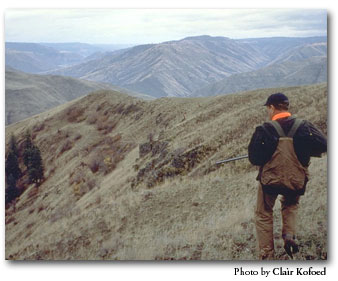 |
|
|
The most popular are the ‘strap’ type vest, which allows layering of clothes and is well ventilated. I use the Filson Game Bag vest, and it is simple and indestructible. Others like the Quilomene models, which have an optional CamelBak water reservoir.
Rubber dog boots and a short lead don’t weigh much, and are handy. The terrain is hard on a dogs feet, so take the boots and duct tape, and learn how to tape them on your dog before going hunting.
Armament
This hard country grows birds that are tough and tenacious of life. Forget about the preserve chukars that you killed with your 28 gauge and three quarters of an ounce of number 8 shot. Hunting below a partner on a very steep slope, I once turned outward and took a chukar that was hurtling down slope as a going away shot. At less than 30 yards I hammered the bird with an ounce of 7-1/2's through an improved cylinder barrel. Feathers exploded and the bird cartwheeled in the air, slamming into an open spot on the opposite side of the draw. Immediately it was on its feet, seemed to shake its head, and took off running directly up a steep slope and into cover! No bird. I suspect that other birds I have downed, apparently hard hit, and been unable to find, have effected similar getaways unobserved.
Now I regularly use a one ounce load of hard sixes or sevens in my 16 gauge Fox. Chokes should accommodate shooting from 15 to 35 or 40 yards — Improved cylinder in a single barrel gun, skeet or improved cylinder and modified in a double. The 28 gauge may have a place in the wild chukar business, but I do not use or recommend it. Effectively taking these birds at the usual 25 to 35 yard ranges requires shot sizes with pattern densities that only one ounce or more of shot can provide. I like a sixteen, bored skeet one and skeet two, which, at six pounds, seems to have a power to weight ratio about right for chukars. Many hunters use a twenty gauge. On the opposite end of the scale, a twelve gauge would be excellent, but unless exceptionally light it would be a burden in the hills.
Tactics
and Shooting
Carry binoculars in your vehicle and scan the slopes for birds. Open, south facing slopes with rocky rims and outcroppings are good places to start. Look for tracks in roadside dust, or droppings in basin heads, saddles and on rock outcroppings. When I find these signs, I park and walk a loop bracketing the elevation where I suspect the birds are, going out a quarter to half a mile or more, and looping back. When hunting alone it is best to be on the same level or above the birds.